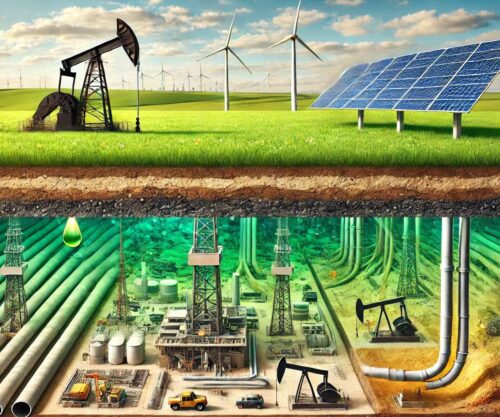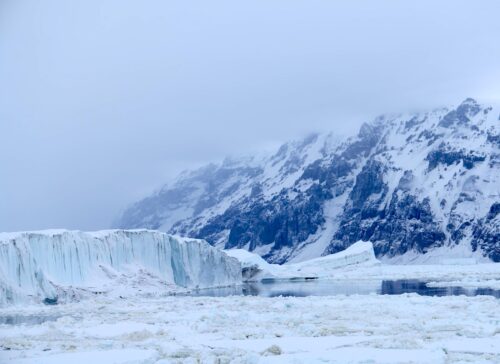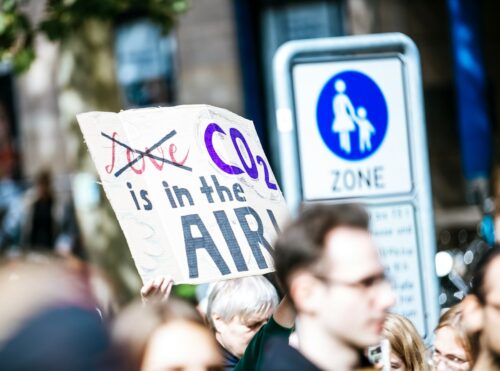 The biggest environmental scare story of 2018 was plastic pollution in the oceans. (It was also, as we shall see – spoiler alert – the year’s biggest lie…)
The biggest environmental scare story of 2018 was plastic pollution in the oceans. (It was also, as we shall see – spoiler alert – the year’s biggest lie…)
From BBC’s Blue Planet II to a special issue of National Geographic to a crusading campaign by the Daily Mail to CNN, the story was rarely out of the media.
Celebrities from Chris Hemsworth to Cara Delevinge leaped on to the virtue-signaling bandwagon. So did politicians such as UK Secretary of the State for the Environment Michael Gove and the European Parliament and US Congress, all announcing new legislation to deal with this alleged scourge.
Suddenly, plastic drinking straws became public enemy number one. No enlightened member of the chatterati could sip a cocktail ever again without pangs of guilt.
Nor could they even clean their ears without a shiver of horror at the thought that today’s waxy cotton bud might be tomorrow’s obstruction in the nostril of a baby sea turtle.
The scare even generated its own word of the year – ‘single-use’, which refers to plastic items (picnic cutlery, straws, earbuds, etc) designed by the heartless capitalist system to be used just once.
But the plastic pollution scare was and is a massive con trick. It’s a fabricated crisis, heavily promoted by environmental charities – most especially by Greenpeace – which depends on scare narratives to fill their coffers.
Plastic pollution in the oceans is certainly a matter of concern. But the way the problem has been presented in the mainstream media is mostly #fakenews.
Most of the legislation drawn up to combat it is economically damaging, intrusive and unnecessary.
Rather than help the environment, it has distracted public attention from more pressing environmental causes, while hurting business, scaring children (and gullible grown-ups), distorting science and enriching and empowering green hucksters.
How do we know this? Because it’s what the science and the evidence tell us.
Greenpeace – the primary source of this scare – have sold us one very expensive, big fat lie. And now, in possibly the most important environmental report published in 2018, they have been exposed for the snake-oil salesmen they are.
You can read the full report here at the Heartland Institute.
The authors – Michael Connolly, Ronan Connolly, Willie Soon, Imelda Connolly and Patrick Moore – weren’t paid a cent for producing it, which speaks volumes about the economic imbalance in the global environmental debate.
On one side you’ve got a $1.5 trillion-plus climate-industrial complex – including $400 million per annum Greenpeace – churning out endless eco-propaganda invariably swallowed whole by a mainstream media desperate for enviro-scare stories.
On the other, you’ve got a handful of ill-funded scientists, journalists, and bloggers doing their best to get the truth out on next to no money.
But why would caring, fluffy environmentalists lie to us about plastic pollution?
Because – as the authors explain in their Analysis of Greenpeace’s business model & philosophy – the charity is primarily a money-making machine which depends for its income on attention-grabbing ‘crises’.
Perhaps you feel a gullible fool for having been taken in by these hucksters. Don’t worry: I was too. I believed there really is a Great North Pacific Garbage Patch the size of Alaska. [Fact check: there really isn’t].
And I too got very upset by the footage on the BBC and elsewhere of coral reefs obscured by bits of plastic, and fish, turtles, even whales – allegedly – being choked on plastic debris.
So is there really no marine plastic pollution problem? Not quite. But it has definitely been very heavily exaggerated.
For example, it’s true that ocean currents push floating debris into parts of the ocean (“gyres”) where the concentration of plastic debris is at least 10 times the concentration elsewhere in the ocean.
But the actual quantity is much smaller than the near-solid masses of plastic bags, bottles and other debris you’ve been led to imagine by the Greenpeace propaganda.
One research vessel, trawling one of those gyres for 10 to 15 minutes over a distance of 0.4 to 0.9 miles recovered plastic fragments which, in total, would not have been enough to fill a thimble.
The largest piece was less than 1.5cm in diameter.
Here is how the Heartland authors sum up the state of play:
Over the last decade or so, several research groups have begun to realize that tiny fragments of plastic (“microplastics”) are present in non-zero concentrations in most of the ocean basins. Since plastics are a human invention, we can directly attribute the existence of these microplastics in the oceans to human activity.
For this reason, several scientists have been actively trying to answer the following questions:
1. Exactly how high are the concentrations of these “microplastics” (as well as larger “macroplastic” fragments)? Are the concentrations evenly distributed and increasing over time?
2. Are they having any biological effects (positive or negative) on ocean life, and what are those effects?
3. Where exactly are these microplastics coming from?
4. If they are a problem or even a potential problem, how could we prevent their concentrations from increasing, and ultimately reduce their concentrations?
In this section, we will provide a brief review of the current scientific opinion on several of these issues, but broadly we can summarise the current answers to those questions as follows,
1. For most of the oceans, the concentrations of “microplastics” are basically negligible. But, in some regions (particularly the “North Pacific Gyre”), you can find a few hundred tiny fragments per square mile. Despite Greenpeace’s claims, large “macroplastics” from land, e.g., plastic bottles, plastic bags, etc., are exceedingly rare.
2. So far, nobody has found any evidence that these microplastics are having negative impacts on ocean wildlife. But, “absence of evidence is not the same as evidence of absence”. So, research into answering this is still ongoing.
3. Much of the plastic seems to come from marine debris such as lost or abandoned fishing nets, tackle, etc. However, the rest seems to come from mismanaged land waste. Current estimates suggest that about 85% is coming from developing nations in Asia (China, Indonesia, etc.), but about 7-8% seems to be coming from developing nations in Africa, and most of the rest seems to be coming from regions in South America and Central America.

4. The concentrations of ocean plastics are far too small – even in the so-called “oceanic garbage patches” – to make it feasible to collect it with current methods, although the Ocean Cleanup Project is investigating possible technological solutions which they believe could make it possible in the future. However, the most straightforward solution to stop or slow down the increase in ocean plastic pollution would be to improve the waste management systems of the coastal developing nations. Despite Greenpeace’s insistence that the developed nations are somehow to blame, the combined contribution of all the countries in Europe and North America is estimated to be less than 1-2%. So, if the developing nations along the coasts of Asia (and to a lesser extent, Africa and South America) were to reduce their mismanaged waste to the levels of European and North American countries, then this would probably resolve most of the issue.
What Greenpeace has successfully done is hijack this so far fairly minor problem by turning it into a global panic, designed primarily to push the guilt-buttons of affluent Westerners.
Key to its strategy has been to fool those Westerners into thinking it’s mainly their problem.
This simply isn’t true. According to a 2015 study by Jambeck et al., here is the rough breakdown of the countries whose poor waste management contributes most of the plastic entering the oceans.
Rank Country Region % Of Mismanaged Waste
1 China Asia 27.7%
2 Indonesia Asia 10.1%
3 Philippines Asia 5.9%
4 Vietnam Asia 5.8%
5 Sri-Lanka Asia 5.0%
6 Thailand Asia 3.2%
7 Egypt Africa 3.0%
8 Malaysia Asia 2.9%
9 Nigeria Africa 2.7%
10 Bangladesh Asia 2.5%
In comparison, they estimate that the United States only contribute to 0.9% of the mismanaged waste, and the EU about 1%
So even if the U.S. and Europe reduced their plastic usage to zero, that would only reduce the oceanic plastic waste problem by a maximum of 2 percent. And that’s a very optimistic estimate.
Another study by Lebreton et al. (2017) puts the European contribution to mismanaged plastic waste at 0.28 percent, Australasia’s at 0.02 percent and Central and North America’s at 0.95 percent (most of that, it goes almost without saying, from Central America rather than the U.S.
To be absolutely clear then, this is not a Western-generated problem. Its solution, very clearly and obviously, lies in somehow encouraging developing nations such as China and Indonesia to clean up their acts and stop allowing so much of their plastic trash leaking into the sea.
Greenpeace is perfectly aware of this. It has cited Jambeck et al. on several occasions, so it knows the truth.
But it also knows that in order to guilt-trip potential donors – most of whom are in the West, not the polluting countries – it needs to gull them into thinking that it’s their responsibility; and also to tap into the hair-shirt obsession so many Western liberals have these days with banning stuff and sanctimoniously, masochistically depriving themselves of products they’ve previously considered quite useful (eg things made of plastic).
Does this #fakenews scare remind you of anything? It should because it uses the same template as every other environmental scare there is from vanishing polar bears and melting icecaps to acid rain, ocean acidification and the mother of all eco-scares “global warming.”
In each case, a negligible problem, often existing only in the realm of theory, is ramped up through cherry-picked data, emotive spin, and appeals to junk-science authority into a major scare story.
The scare story receives widespread coverage in the mainstream media. Politicians, being keen to be seen responding to an environmental issue of apparent public concern, leap in with new legislation…
…Then, years later, it will be discovered that the problem wasn’t nearly as serious as the environmentalists claimed and that the policies introduced to deal with the non-problem have done far more damage than the non-problem itself ever could.
The main difference between the plastics pollution scare and all the other environmental scares is that the plastics scare has legs.
It has taken off in a way that Greenpeace can scarcely have dreamed when it announced in its 2015 annual report that plastics pollution was one of the issues it was going to start pushing:
“A striking example of how threatening we humans have become for our own life-supporting systems is plastic pollution in the ocean. We produce over 300 million tons of plastic every year. That is equivalent to the combined weight of all the adult humans on Earth. Between 25 and 35 million tons of this plastic ends up in the ocean – annually. And once it is there it stays there. In 2015, the ocean contained 1 ton of plastic for every 3 tons of fish. If this rate of pollution continues, by 2050 the amount of plastic in the ocean is expected to match the amount of fish by weight. The ocean and the creatures living in it are literally choking on plastics.” – Greenpeace International 2015 Annual Report.
You can loathe these soap-dodging tree-huggers for their lies, their greed, their dishonesty, their socialism-masquerading-as-love-of-nature, their hypocrisy, their cant.
But you’ve got to admit their marketing genius. Truly this has got to rank among the most successful propaganda campaigns since the era of Josef Goebbels.
Consider where we are at the end of 2018: if there’s one thing every bleeding heart Westerner knows about the environment, it’s that “single-use” plastics are the biggest threat of our age – slaughtering whales, choking ickle baby turtles, upsetting David Attenborough, generating thousands of acres of columns by everyone from George Monbiot to Caitlin Moran, and enabling all manner of celebrities to parade their virtue on wanktastically pointless schemes like this one.
The ocean plastics pollution scare is a strong candidate for the biggest lie of 2018.
Many congrats, Greenpeace. You must be so proud!
Read more at Breitbart



















Plastics like DDT will soon become the target for the various Eco-Wacko crusaders wanting get on their horse take up their swords and slay the Plastic Dragon that’s only in their minds they are Delusional and redicuous we al want to protect the Sea Birds and Whales but lets use some Common Sense